Contents
Resources
° Jessamyn's Regency Costume Companion
° Regency 1
° Regency 2
° Regency 3
° Regency 4
° Regency 5
° Regency 6
° Regency 7
° Regency Clothes
° Regency Garderobe
° Regency Fashion Page
° Sense & Sensibility Vintage Images
Books to Read
Patterns of Fashion 1 by Janet Arnold
Period Costumes for Stage & Screen: 1800-1909 by Jean Hunnisett
The Cut of Women's Clothes by Norah Waugh
Movies to Watch
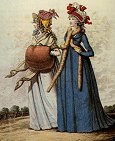
Gowns from 1795; image courtesy of Regency Fashion Page.

Evening gowns also from 1795; image courtesy of Regency Fashion Page.
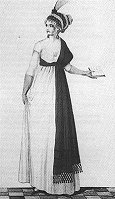
Dress from 1798 illustrating the classical influance in fashion; image courtesy of Regency Fashion Page.

Research
Although I've done some research before this point, I felt that I needed to go picture hunting online to get a better grasp of the 'look'. I've broken down some of my findings into garment group (only those that I will be making).
Chemise
The chemise is the garment that goes closest to your skin. It not only helps to keep body oils and perspiration off of one's clothes, but also serves as a barrier between your skin and the corset, which can chafe otherwise. Having seen and handled a couple period chemises, here are my observations:
Chemises of the period are white (I have yet to find a picture or see one that is of another color). At this period, they are very utilitarian, and lack the 'fancies' that would be added to decorate chemises later in the 19th century. A suitable substitute for linen would be 36" wide muslin sold at chain stores like JoAnn's.
Corset
Also known as stays. While there is a ongoing controversy of who wore corsets, or if corsets were even widely worn, it seems logical for several reasons why one should wear a corset under the Empire style gowns. Firstly, the sheer number of surviving corsets from the 1800-1825 period indicates to me (this is my personal opinion only) that they were probably worn by most women. While there seems to have been a fad in the early years of the 19th century for not wearing a corset, for most women, it is more comfortable to have some bust support. Period illustrations suggest that the time when corsets were most widely out of favor was the early Empire period, as the busts in many paintings and illustrations seem to be relatively unrestricted. After about 1810, the tightness of the bodice, and the 'lift and separation' of the bust-line suggests corsets becoming widely in use again.
Corsets of this era were actually quite unstructured in comparison to the 18th century stays, worn just a few years before. Made of fabrics of a similar weight to twill or even linen, they usually consisted of a busk, some boning, cording, and lacing up the back. Gussets were used to support and lift the bust-line to the fashionable height. I have seen one corset from the period that does not have cording or boning, but only a busk pocket. One must suppose though that it could have been for a young girl or else a very small woman (about a misses' size 2). The other corsets I have seen have more elaborate means to support and cording with a small amount of boning seems to have been the most popular.
For further reading on undergarments of this period, check out Jessamyn's Regency Costume Companion.
Gowns of the Empire period were highly influenced by classicism and the ancient Roman and Greek cultures. In what can be called the beginning of the classical influence, the gowns of the late 18th century were not as pure in classical form as those to follow were. The gowns on the left (click on thumbnail to view full image) are very typical of the style of the 1790s. While the thrust was increasingly towards simplicity, there are still bits of the mid 18th century busyness about the gowns.
By the last couple years of the 18th century and up until roughly 1805, gowns had adopted what I like to refer to as the 'pure classical' form; fashions of later date would never quite achieve the 'Grecian' look again. As you can see in this illustration (click here to view), the gown of 1801 is characterized by light, draping fabrics that cling to the body. While such exposure of the form does not seem strange to the modern eye, it was quite unusual at the time; the garments of decades before carefully hid ladies' forms. Also note the 'natural' pose and look of the figure. It's very unrestricted at this point, due to light corseting and minimal undergarments.
Gowns of the period ranged all over the map in style and construction. Many of the early gowns did not close in back, but rather down the front, either with drawstrings or by hiding the closing under a bib. The bib was usually concealed well enough that to the modern eye, it isn't always obvious how the gown is fastened. Sleeves ranged from short to long, but all tended to be rather fitted as opposed to the puffed sleeve which didn't gain popularity until around 1805. Some sleeves were also draped at times to suggest Grecian robes, though that went out of style fairly quickly.
Fabrics of the period tended to be light, soft materials that skimmed over the figure-India muslin being the most popular. Whether left in plain white or embroidered by skilled craftsman, it was the epitome of the 'look' for the era. Muslin was, however not the only choice for fabrics-varying weights of cotton and silks were popular as well. White was the prevailing color worn at that period, but it was not the only hue; study of fashion plates reveal colors such as soft blues, yellows, pinks and richer colors for full dress or formal wear.
Often the gowns were trimmed with embroidery ranging from classical symbols (the Greek key), to flowers and leaves. Simplicity was the fashion, and the embroidery and trims of the period tend to be understated in comparison with the elaborate embellishments of the 18th century. Embroidery could be worked in a matching color to the gown fabric, or in some cases a contrasting color or even a precious metal (such as gold or silver) was used to carry out a design.
Font courtesy of Font Face.
Please contact the webmaster if you are experiencing any technical difficulties with this site.
©2003 Miss C.
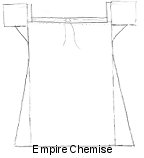
Quick sketch of an Empire chemise (shift).
Click on images for larger views.
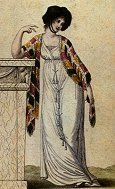
Morning dress from 1801; image courtesy of Regency Fashion Page.
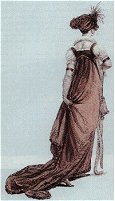
'Full dress' from 1803; image courtesy of Regency Fashion Page.